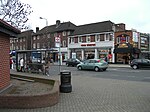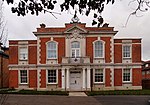All Saints, Chingford
12th-century church buildings in EnglandChingfordChurch of England church buildings in the London Borough of Waltham ForestGrade II* listed buildings in the London Borough of Waltham ForestGrade II* listed churches in London ... and 1 more
Use British English from February 2015

The Church of All Saints, Chingford, also known as Chingford Old Church, is a Grade II* listed Church of England church at Old Church Road, Chingford, London E4. Parts of the church date back to the 12th and 13th centuries, but it now forms part of the parish of St Peter and St Paul, Chingford, which took over its role as the parish church in 1844. The church stands on the summit of Chingford Mount and has views westwards towards the reservoirs of the Lea Valley.
Excerpt from the Wikipedia article All Saints, Chingford (License: CC BY-SA 3.0, Authors, Images).All Saints, Chingford
Old Church Road, London Highams Park (London Borough of Waltham Forest)
Geographical coordinates (GPS) Address External links Nearby Places Show on map
Geographical coordinates (GPS)
| Latitude | Longitude |
|---|---|
| N 51.622499 ° | E -0.01698 ° |
Address
All Saints (The Old Church)
Old Church Road
E4 8BU London, Highams Park (London Borough of Waltham Forest)
England, United Kingdom
Open on Google Maps








